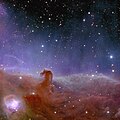Arkivo:Euclid’s view of the Horsehead Nebula ESA25170866.jpg

Arkivo originala (8 200 × 8 200 pixel-i, grandeso dil arkivo: 1,84 MB, MIME type: image/jpeg)
Ca arkivo jacas en Wikimedia Commons, e povas uzesar en altra projeti. La deskriptado en lua pagino di deskriptado montresas adinfre.
Titulo
| DeskriptoEuclid’s view of the Horsehead Nebula ESA25170866.jpg |
English: Euclid shows us a spectacularly panoramic and detailed view of the Horsehead Nebula, also known as Barnard 33 and part of the constellation Orion.
At approximately 1375 light-years away, the Horsehead—visible as a dark cloud shaped like a horse’s head—is the closest giant star-forming region to Earth. It sits just to the south of star Alnitak, the easternmost of Orion’s famous three-star belt, and is part of the vast Orion molecular cloud. [Image description: This square astronomical image is divided horizontally by a waving line between a white-orange cloudscape forming a nebula along the bottom portion and a comparatively blue-purple-pink upper portion. From the nebula in the bottom half of the image, an orange cloud shaped like a horsehead sticks out. In the bottom left of the image, a white round glow is visible. The clouds from the bottom half of the image shine purple/blue light into the upper half. The top of the image shows the black expanse of space. Speckled across both portions is a starfield, showing stars of varying sizes and colours. Blue stars are younger and red stars are older.] Tiếng Việt: Tinh vân Đầu Ngựa, còn được gọi là Barnard 33 và là một phần của chòm sao Orion |
| Dato | la 7-a de novembro 2023 (alŝuta dato) |
| Fonto | Euclid’s view of the Horsehead Nebula |
| Autoro | ESA/Euclid/Euclid Consortium/NASA image processing by J.-C. Cuillandre (CEA Paris-Saclay) G. Anselmi |
| Altra versioni |
|
| Activity InfoField | Space Science |
| Keyword InfoField | Horsehead Nebula Stars |
| Mission InfoField | Euclid |
| Set InfoField | Euclid First Images |
|

|
This image was selected as picture of the day on Vietnamese Wikipedia.
|
Licencizo
This media was created by the European Space Agency (ESA).
Where expressly so stated, images or videos are covered by the Creative Commons Attribution-ShareAlike 3.0 IGO (CC BY-SA 3.0 IGO) licence, ESA being an Intergovernmental Organisation (IGO), as defined by the CC BY-SA 3.0 IGO licence. The user is allowed under the terms and conditions of the CC BY-SA 3.0 IGO license to Reproduce, Distribute and Publicly Perform the ESA images and videos released under CC BY-SA 3.0 IGO licence and the Adaptations thereof, without further explicit permission being necessary, for as long as the user complies with the conditions and restrictions set forth in the CC BY-SA 3.0 IGO licence, these including that:
See the ESA Creative Commons copyright notice for complete information, and this article for additional details.
|
 | |
Ĉi tiu dosiero estas disponebla laŭ la permesilo Krea Komunaĵo Atribuite-Samkondiĉe 3.0 Interregistara Organizaĵo. Atribuo: ESA/Euclid/Euclid Consortium/NASA, image processing by J.-C. Cuillandre (CEA Paris-Saclay), G. Anselmi, CC BY-SA IGO 3.0
| ||
This file, which was originally posted to
Euclid’s view of the Horsehead Nebula, was reviewed on 13 November 2023 by reviewer Юрий Д.К., who confirmed that it was available there under the stated license on that date.
|
Titoloj
Kozi montrata en ca arkivo
montras Esperanto
Ĉevalkapa Nebulozo Esperanto
stato de kopirajto Esperanto
sub kopirajto Esperanto
permesilo Esperanto
MIME-tipo Esperanto
image/jpeg
alteco Esperanto
8 200 Pixelo
larĝeco Esperanto
8 200 Pixelo
datena grando Esperanto
1 925 643 Bicoko
kontrolsumo Esperanto
c128318f38ea88c7da0a62dc209a407e6cf41e26
7 nov. 2023
fonto de dosiero Esperanto
pHash-a kontrolsumo Esperanto
5qju5gik7a1tmf81iz4c7n0btv09ef7iz94girulklo143cu3c
Vikimedia Komunejo: Elstaraj bildoj Esperanto
Historio dil arkivo
Kliktez sur la dato/horo por vidar arkivo quale ol aparis ye ta tempo.
| Dato/Horo | Miniaturo | Dimensioni | Uzero | Komento | |
|---|---|---|---|---|---|
| aktuala | 18:50, 7 nov. 2023 |  | 8 200 × 8 200 (1,84 MB) | OptimusPrimeBot | #Spacemedia - Upload of https://www.esa.int/var/esa/storage/images/esa_multimedia/images/2023/11/euclid_s_view_of_the_horsehead_nebula/25170855-1-eng-GB/Euclid_s_view_of_the_Horsehead_Nebula.jpg via Commons:Spacemedia |
Ligilo al imajo
Nula pagino ligesas ad ica pagino.
Uzado en altra Wiki
La sequanta Wiki anke uzas ica arkivo:
- Uzado en fr.wikipedia.org
- Uzado en he.wikipedia.org
- Uzado en ru.wikipedia.org
- Uzado en vi.wikipedia.org
Metadonaji
Ca arkivo kontenas plusa informo, probable furnisita per la kamero elektronikala o per la "scanner" uzata por krear o kopiar l'imajo.
Se l'arkivo modifikesos de lua originala stando, kelka detali povos ne reprezentar exakte l'arkivo modifikata.
| Titolo de bildo |
|
|---|---|
| Dio e horo di produktado di la datumaro | 00:00, 29 okt. 2023 |
| Komponaĵo de rastrumeroj | RGB |
| Orientizo | Normala |
| Horizontala distingivo | 1 dpi |
| Vertikala distingivo | 1 dpi |
| *Komputeroprogramo uzata | GIMP 2.10.18 |
| Dio e horo di la modifiko dil arkivo | 09:54, 29 okt. 2023 |
| Unika identigo de originala dokumento | xmp.did:93eb5251-7bdb-4a71-84ac-e2d7aedbd77e |
| IIM-versio | 2 |



